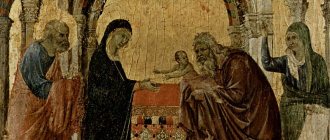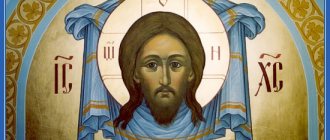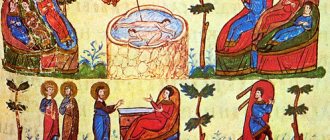Russia
Moscow
Robe of the Lord
Robe of the Lord
- a seamless tunic, received by lot by one of the soldiers who were at the crucifixion of Jesus Christ. According to the Gospel narrative, His tunic - the Robe of the Lord - went by lot to one of the soldiers: “So they said to each other: “Let us not tear it apart, but let us cast lots for it, whose it will be,” so that what was said in Scripture might be fulfilled: “They divided My garments among they cast lots for themselves and for My clothing” (John 19:24).
See also: Titlo from the Cross of the Lord
Historical excursion[edit]
Various eastern legends tell about the circumstances of the transfer of the Robe of the Lord from Jerusalem: Armenian, Georgian, Syrian.
According to legend, the warrior who received the Robe of the Lord was a Georgian and subsequently brought it to Georgia. According to another legend, within Iberia (Georgia), since the time of the Babylonian captivity, a community of Jewish settlers settled, whose descendants lived in Mtskheta, the ancient capital of Iberia. Mtskheta Jews annually sent their envoys to Jerusalem to participate in the celebration of the Old Testament Passover. One of them, named Elioz, was an eyewitness of the suffering of Jesus Christ on Golgotha and believed in the Savior. He managed to acquire the Robe of the Lord from the warrior who received it by lot, and returned with it to Mtskheta (see “Truth and Life” No. 4/96). The Robe of the Lord remained in Georgia until the beginning of the 17th century.
The further fate of the Robe of the Lord is closely connected with the history of relations between three states: Georgia, Persia and Russia. When in 1616–1617. Georgia was conquered by the Persian Shah Abbas I, the Russian Tsar Mikhail Fedorovich, in response to the request of the Georgian Tsar Teimuraz for help, took him under his protection. In 1622, during negotiations about the future fate of Georgia and Tsar Teimuraz, the Shah told Russian envoys that he had the Robe of the Lord, which he allegedly took from Georgia and intended to send to Tsar Mikhail Fedorovich and Patriarch Filaret Nikitich to Moscow.
In ancient Russian writing there are several legends about how the Robe of the Lord came to Moscow. One of them belongs to a famous writer of the 17th century. to Prince Semyon Shakhovsky (it was placed in a handwritten collection kept in the collection of Academician N.S. Tikhonravov). The authentic acts testifying to the delivery of the Robe of the Lord to Moscow were kept in the Moscow Main Archive of the Ministry of Foreign Affairs; in 1879 they were published, subsequently the “Case of sending the Robe of the Lord to Moscow by Shah Abbas”, which belonged to the same archive, was also published. The texts of the embassy documents are given in the study by S. Belokurov “The Case of Shah Abbas sending the Robe of the Lord to Tsar Mikhail Feodorovich in 1625” (1891). Facsimile fragments of this correspondence are also included there.
It should be noted that in the West there was a legend that the Robe of the Lord was originally found by Queen Helena (IV century) in Palestine, transferred to Trier and in 328 placed in the Trier Cathedral. This “alternative” tradition appeared in Western Europe in 1196, and in 1512 popular veneration of the Trier relic was established here.
...Shah Abbas kept his word: in March 1625, the Persian ambassador Urusambek brought the honorable Riza to Moscow as a gift to His Holiness Patriarch Philaret from Shah Abbas. The shrine was placed in a golden ark decorated with precious stones. Together with him, the ambassador presented the Patriarch with a letter in which the Shah informed that, having conquered Georgia, he had found this shrine in the metropolitan’s sacristy, hidden in the cross. On the same day, Patriarch Philaret with the entire sacred cathedral inspected the ark: “And after inspection in that ark (it turned out) part of a certain linen, if reddish, looked like shallows, or would have changed its face from long ago, and the fabric was in wool, and in length and across a span.”
Position of the Robe of the Lord in the Assumption Cathedral of the Moscow Kremlin
Since the Robe was sent by a king of other faiths, and “the word of the infidels without testing is not accepted as a testimony,” they began to look for evidence of the authenticity of the sent shrine. The Greek and Jerusalem bishops and archimandrites, who were in Moscow at that time, unanimously confirmed that their Churches preserved the tradition that the Robe of the Savior was kept in Georgia, where it was transferred by a soldier who was at the crucifixion of Jesus Christ.
But Patriarch Filaret wished to have a testimony from above. The decree of March 22, 1625 commanded: “In all monasteries, keep a seven-day fast and in all churches pray to the Lord God that He Himself will reveal His will about that shrine; and carry the most holy thing around the city with the singing of prayers in religious processions and place it on the sick.”
Many sick people received healing after the Robe of the Lord was placed on them. 14 cases of miraculous healings from the Robe of the Lord were identified during the Week of the Cross (4th week of Lent). This indisputably testified to the authenticity of the Robe of the Lord. On March 27, the honorable Robe was solemnly laid in the Assumption Cathedral of the Moscow Kremlin. Soon, to store the “very rich treasure,” a copper tent was built in the southwestern corner of the cathedral, in the chapel of St. apostles Peter and Paul.
Although the Robe of the Lord was brought to Moscow in March, because of Lent in those days, the celebration of the Position of the Honest Robe in Moscow was established on July 10 (Old Art.) - on the eve of the elevation of Mikhail Fedorovich to the kingdom. The service for the holiday, with the blessing of His Holiness Patriarch Philaret, was composed by Metropolitan Cyprian of Krutitsa (Sara and Podonsk). On the day of the holiday, the shrine was taken to the middle of the temple for the worship of believers.
According to the inventory of the Assumption Cathedral of 1627, there were three parts of the Robe of the Lord in the temple. “On the Holy Sepulcher the ark is silver and gilded, on the ark is a carved image of the Crucifixion of our Lord Jesus Christ; and in that ark there is another silver ark, gilded, and in the ark is the Robe of our Lord Jesus Christ... The icon case is silver, in it a part of the Robe of the Lord lies on the Holy Sepulcher... The smaller icon case is silver, gilded, in it is part of the Robe of the Lord, under the seal of the great sovereign, His Holiness Patriarch Filaret Nikitich, Moscow and All Rus'. On the ark is the image of the Crucifixion of the Lord, along the edges trimmed with pearls in one strand, at the head is the image of the Savior...”
From other places in the inventory it follows that one part of the Robe was called large, the second - smaller, and the third was intended to be worn to the homes of the sick. In addition, particles of the Robe were sent to monasteries. So, already in 1626, Patriarch Filaret transferred a small part of it to the Ipatiev Monastery near Kostroma.
Around 1627, the icon “Position of the Robe of Christ” was painted. On the Feast of the Placement of the Honorable Robe of the Lord, the Nail of the Lord was also honored with it. In 1688, he was brought to Moscow by the Georgian Tsar Archil Vakhtangovich, who moved here to live; Later, by decree of Peter I, it was ordered that the Nail of the Lord be given for storage to the Assumption Cathedral.
Orthodox Christians in great numbers came to the Assumption Cathedral to venerate the Robe of the Savior. Possessed by serious illnesses, unable to reach the cathedral, they asked to bring the Robe of the Lord to their home for healing. They asked so often that the Riza was divided into several parts. In addition, believers, accepting the Robe of the Lord in their homes, separated small particles from it. They did this out of a reverent desire to have a shrine in their home, but in this way they unwittingly caused harm to it.
Therefore, in 1681, His Holiness Patriarch Joachim was forced to issue a special command: “... so that in future this very rich treasure should not be divided into parts.” According to this decree of the Patriarch, two arks were made to store the Robe of the Lord. In the first, part of the Robe was kept together with part of the Life-Giving Tree of the Cross of Christ. This ark was erected in the temple once a year, on Good Friday. Paul I, having accepted the reign (1796–1801), ordered this ark with the Robe to be transported to St. Petersburg, to the Cathedral of the Winter Palace. Another part of the Robe was kept in the Peter and Paul Cathedral, “in the fortress.”
The second ark with part of the Robe still remained in the Assumption Cathedral of the Kremlin. This is what the Moscow part of the shrine looked like: “The part of the Robe of the Savior available in the Assumption Cathedral is slightly more than an inch square; it is arranged in a golden reliquary, which, in turn, is arranged in a silver casement case (6 1/2 x 4 inches), covered with blackened sacred images and decorated in the middle under glass with 180 large diamonds, of which one weighs 7 1/ 2 carats." The remaining part of the shrine in Moscow, as before, was taken out annually for worship.
In 1701, Peter I started a war with Sweden: Russia was fighting for access to the Baltic Sea. Difficult trials lay ahead, and the tsar ordered the construction of the Church of the Deposition of the Robe in Moscow - a stone temple at the meeting place of the Robe of the Savior, once brought to Russia by the Persian embassy. However, the Robe itself was still kept in the Assumption Cathedral. Judging by the inventories, in 1701 five arks with eight pieces of the Robe of the Lord were kept here. Two parts of the Riza were sent to St. Petersburg, one to Yaroslavl.
For centuries, the shrines kept in the Assumption Cathedral of the Kremlin were protected from the gaze of strangers - they could only contemplate them from afar.
There was no access to the Robe of the Lord during the “invasion of the Gauls,” when Moscow was occupied by Napoleonic troops. She, along with other shrines, was promptly transported from Moscow to Vologda. After the victory over Napoleon, the patriarchal sacristy was returned from Vologda to Moscow, and the Robe of the Lord took its former place in the Assumption Cathedral.
In 1837 A.N. Muravyov, who in those years served as “secretary at the chief prosecutor’s table” in the Holy Synod, was in the retinue of Grand Duke Alexander Nikolaevich (future Emperor Alexander II), when he, accompanied by Metropolitan Philaret (Drozdov) of Moscow, inspected the churches of the Moscow Kremlin. He also visited the sacristy of the Assumption Cathedral, which was saved during the Patriotic War of 1812. Talking about this visit, Muravyov, in particular, Fr.
This remark is confirmed by information contained in the sacristy inventory of the Church of the Winter Palace in St. Petersburg. It mentions “the image of the Mother of God of Tikhvin, in a golden robe, with a cross, in which are particles of the Robe of the Savior and the Mother of God. On the back of the image is the inscription: “In this image, Empress Maria Feodorovna blessed the sovereign Emperor Alexander Pavlovich on the day of his baptism, December 20, 1777.” And the cross was then placed on him.” It follows that the Robe of the Lord was under the jurisdiction of the royal family, and Russian rulers could dispose of the shrine at their own discretion.
The inventory of the Church of the Winter Palace in St. Petersburg confirms that the ark with part of the Robe of the Lord was “received into the sacristy from the rooms of the sovereign Emperor Paul I.” The list contains detailed information about the revered shrine: “The golden ark, built like a book, contains part of the Robe, or Tunic of our Lord Jesus Christ, sewn on a silk pillow. The ark is decorated with enamel images of the four evangelists and the suffering of the Lord, also with diamonds, jahonts and emeralds...” Briefly mentioned is another, silver ark, in which part of the Robe was also kept: “The ark is silver, gilded, with parts of the Tree of the Cross of the Lord, the Robe of the Lord and the relics various saints." A piece of the Robe was reverently preserved in the palace church at the beginning of the twentieth century.
Another part of the Robe of the Lord was kept in the Cathedral of Sts. until 1917. the apostles Peter and Paul (“in the fortress”). It is possible that the “Peter and Paul” part of the Riza was brought to the northern capital by order of Paul I, like the “palace” part, but there is no reliable information on this matter.
Particles of the Robe of the Lord were preserved not only in Orthodox churches, but also in some noble families. Here is what Alexandra Petrovna Arapova, the daughter of Natalya Nikolaevna Pushkina-Lanskaya, writes: “From time immemorial, the family of the Pushkin boyars kept a metal amulet with the All-Seeing Eye rather roughly engraved on it and a particle of the Robe of the Lord tightly enclosed in it. She is the obligatory property of the eldest son, and he is obliged to serve a prayer service in front of this shrine on July 10, the day of the Feast of the Placing of the Robe. Pushkin fulfilled this all his life and bequeathed to his wife to observe the same, and when the time comes, to hand it over to her eldest son, making him promise never to deviate from the family vow.”
After 1917, the St. Petersburg ark with part of the Robe of the Lord apparently suffered the same fate as other shrines kept in the Peter and Paul Cathedral: in May 1922, most of the church valuables were confiscated, and in 1924 the cathedral was converted to the museum.
As for the “Pushkin” part of the Robe of the Lord, the amulet, in all likelihood, passed from the son of the great poet, Alexander Alexandrovich Pushkin, to his granddaughter. After the October revolution, this shrine of the Pushkin house with the granddaughter of Alexander Sergeevich Elena Alexandrovna von der Rosenmayer went to Constantinople. In 1942, Elena Alexandrovna died in Nice. The trace of Pushkin's shrine was lost...
The fate of the parts of the Robe of the Lord that were in the Moscow Assumption Cathedral is also dramatic. “The Bolsheviks ruled here mercilessly, systematically, more mercilessly than the French in 1812,” Paul Schaeffer, a correspondent for the Berliner Tageblatt newspaper, testified in 1922 about the state of the Kremlin cathedrals after the “confiscation” of church valuables.
The further fate of the “Moscow” part of the Robe of the Lord is reported by modern researcher N. Eneeva: “According to the employees of the Moscow Kremlin Museums, after the revolution, in 1918, the shrines stored in the altar of the Assumption Cathedral were transferred to the Holy Cross Monastery, which was located nearby, at the beginning of the Vozdvizhenskaya streets. When the monastery was closed and destroyed, and its clergy were arrested, the shrines were confiscated from the Church and placed in the funds of the Moscow Kremlin Museums, where they were preserved (sometimes with great difficulty and danger) by museum workers intact until the present day. Among them is the ark with the Robe of the Lord, which ended up in the department of precious metals, where it is kept to this day.”
Another piece of the Robe is now in the Moscow Church of the Deposition of the Robe on Donskaya Street. It was transferred here by His Holiness Patriarch Alexy I in 1951, in connection with the 250th anniversary of this church. And Patriarch Alexy I, in turn, previously received this shrine as a gift from the Patriarch of Alexandria.
At the end of 2003, the administration of the Yaroslavl Historical and Architectural Museum-Reserve "Spassky Monastery" made a sensational statement: a piece of the Robe of the Lord, which was considered lost during the years of the revolution, was discovered in its funds.
...The chief curator of the museum, Marina Fesenko, put something wrapped in a large piece of cloth on the table, put on white gloves and unwrapped a silver, gilded ark made in the shape of the Holy Sepulcher. Marina Leonidovna opened the lid of the ark - in the center of the bas-relief depicting rays of light diverging in different directions, lay an octagonal silver panagia, decorated with four precious stones. In the center of the panagia, under a plate of mica, lay a piece of linen fabric the size of a fingernail, which was of enormous value for the entire Christian world.
In 1650, this piece of the Robe of the Lord was presented by Tsar Alexei Mikhailovich to the Yaroslavl merchants, the Skripin brothers, for their great merits. During the Troubles, the militia of Minin and Pozharsky, before the liberation campaign against Moscow, stood in Yaroslavl for a long time and was supported by the money of Yaroslavl merchants, and above all the Skripin brothers. To store the shrine, they specially built the Church of Elijah the Prophet, where a piece of the Robe of the Lord was transferred with the blessing of Patriarch Joseph of Moscow and All Rus'.
The shrine remained there until 1922, when the notorious decree of the All-Russian Central Executive Committee was issued on the confiscation of church valuables to help the famine-stricken in the Volga region. Since then, it was considered lost, although, as it turned out, all this time it was kept in museum collections under a different name. The ark and panagia were kept under different numbers simply as church utensils, and even information about their origin was distorted. According to museum workers, this was done deliberately, in order to save the relic from the Bolsheviks, who, without a doubt, would have destroyed it.
In those years, this form of saving church relics was practiced everywhere. People believed that sooner or later the true meaning of these values would be revealed. And so it happened. Elena Burdakova, a researcher at the Yaroslavl Spassky Monastery Museum, who was preparing the next exhibition, came across a description of the shrine in a book by the Yaroslavl philanthropist Vakhromeev, published in 1906. This happened on Easter 2002.
On April 9, 2004, on Good Friday, the shrine was transferred to the Russian Orthodox Church and placed for worship in the Spaso-Vvedensky Tolga Convent. Since December 1, 2007, the Robe of the Lord has been in the Cathedral of Christ the Savior.
For almost three centuries the Robe of the Lord was preserved and revered in Rus'. And although subsequently most of the revered shrine was lost, for which the “new ingratitudes” were to blame, its memory remains in the liturgical heritage of the Russian Orthodox Church. And this gives hope for the spiritual revival of Russia: “Thy honorable robe, O Lord, which covers Thy Divine and Most Pure body, is a garment of healing given to us.”
Troparion, kontakion and canon for the holiday
Troparion, tone 4.
Today we are coming back, to the greater and 3 celebon0sney rise of sp7si1telz our bGa, having 3revulsed this 2 flesh of diarrhea, and 3 on top of our 2 blood and 3 illustriousness. є3yu1 and3buy2 us t the work of the enemy. all the more gratefully we sing 3мu2, save 2 our countries and 3 ґрхєрез and 3 city. and3 all people will defend themselves honestly2. and3 save2 our soul, you human lover.
Today, as a runner of faith, to the divine and celibate Robe of our Savior God, who deigned to wear this flesh and pour out His holy blood on the Cross, with it redeem us from the work of the enemy. Thus we cry out to Him with gratitude, save our country and the bishop and the city. And protect all people with Your honest Robe. And save our soul, as a lover of mankind.
Kontakion, tone 4.
This is imperishable, saved the whole body, gave all people in the world 3si2, its divine treasure, an honest r1zu, and also the existence of hell. є3yu1 already life-giving and 3 s™y flesh in a lot of its own way. Then we would like to warmly celebrate. With fear and 3 love, I praisingly call the benefactor, preserve 2 peace in our country and 3 GRKHIEREZ and 3 all people, extend your mercy.
The Robe of incorruption, saving healing, the Lord bestowed upon all mankind, Your divine treasure, the Honest Robe, which is the Chiton. With it you deigned to clothe the life-giving and holy flesh of Your incarnation. Toya, with our desire, we celebrate lightly and acceptably. With fear and love, as we praise the Benefactor, we call You Christ, preserve our country and the bishop and all the people in humility, according to Your great mercy.
Library of the Russian Faith Canon of the Position of the Robe of the Lord →
Read online
Because the Jewish priests had similar clothes
Old Testament priests had special clothes. According to the Holy Scriptures, God himself commanded the prophet Moses to sew special clothes for them - “for greatness and beauty.” To do this, it was necessary to take blue, purple and crimson fabric - wool or linen, and embroider them with gold.
The clothing of the Jewish priests consisted of a chiton - an undershirt that reached to the floor, an upper robe, an ephod covering the back and chest, a belt and a turban - a turban. On top of the ephod the high priest wore a breastplate decorated with precious stones.
Through the prophet Ezekiel, God commanded the priests to use vestments only for sacred ceremonies and to remove them before leaving the temple into the outer court, changing into everyday clothes (Ezek. 44:19).
This clothing to some extent became the prototype of the modern vestments of Orthodox priests. Nowadays, they change clothes in the same way, leaving their clothes in the temple.
Position of the Robe of the Lord. Icons
Around 1627, the icon of the Position of the Robe of Christ was painted. The icon depicts the Robe of the Lord in the Assumption Cathedral of the Moscow Kremlin, surrounded by saints and Orthodox people.
Position of the Robe of the Lord in the Assumption Cathedral of the Moscow Kremlin. Moscow. Around 1627. GMMK Inv. Zh-280/1-2
Position of the Robe of the Lord in the Assumption Cathedral of the Moscow Kremlin. Popov Petr Ivanov Kostromitin. Mid-17th century (before 1651?). Yaroslavl Historical, Architectural and Art Museum Reserve, Yaroslavl
The clothes did not appear immediately
Christians did not immediately have liturgical clothes, because the Savior wore ordinary clothes, and the apostles celebrated the Eucharist in everyday attire. Nevertheless, the understanding that it was necessary to serve God in special clothes already existed: the Apostle James wore the clothes of a Jewish priest, and the Apostle John put a gold bandage on his head - the sign of the high priest.
Over time, Christ's everyday clothing became sacred, the tunic and vestments remained part of the vestments of priests, and until the 7th century, the main canon of vestments for ministers of the Orthodox Church was formed.











